
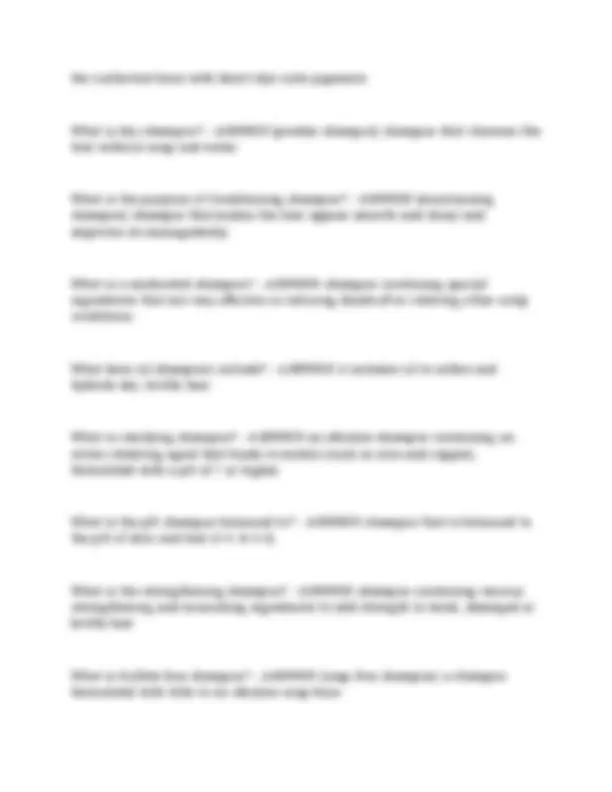
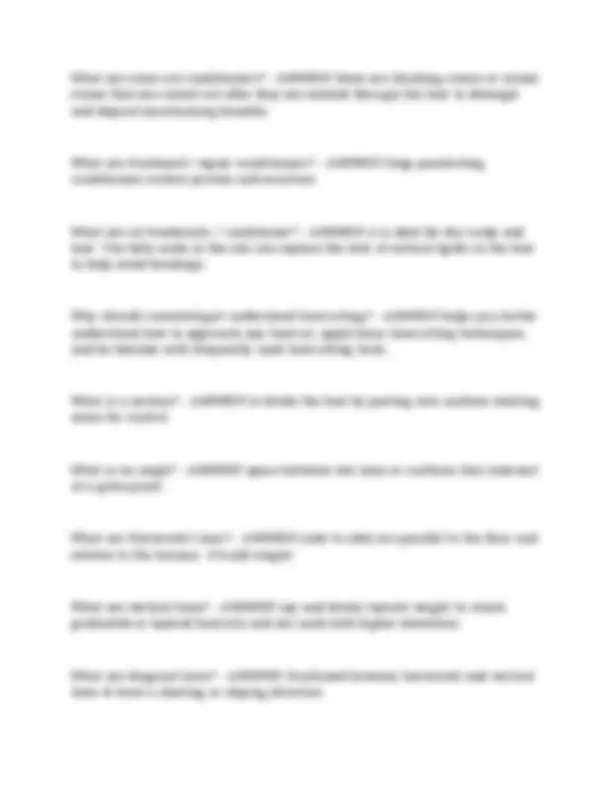
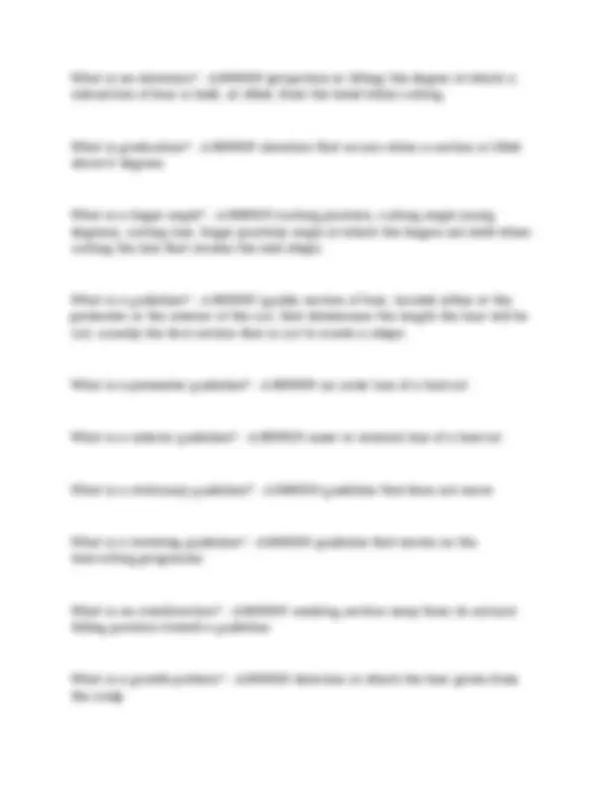
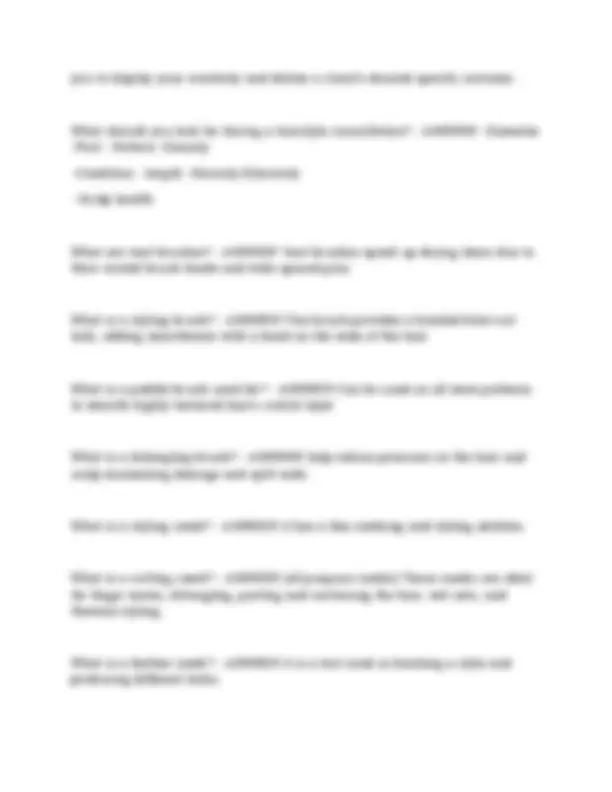
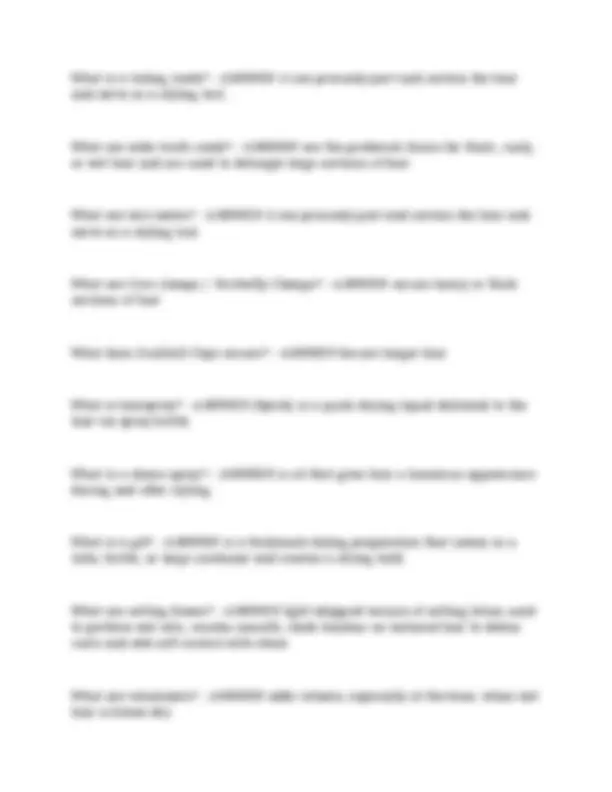
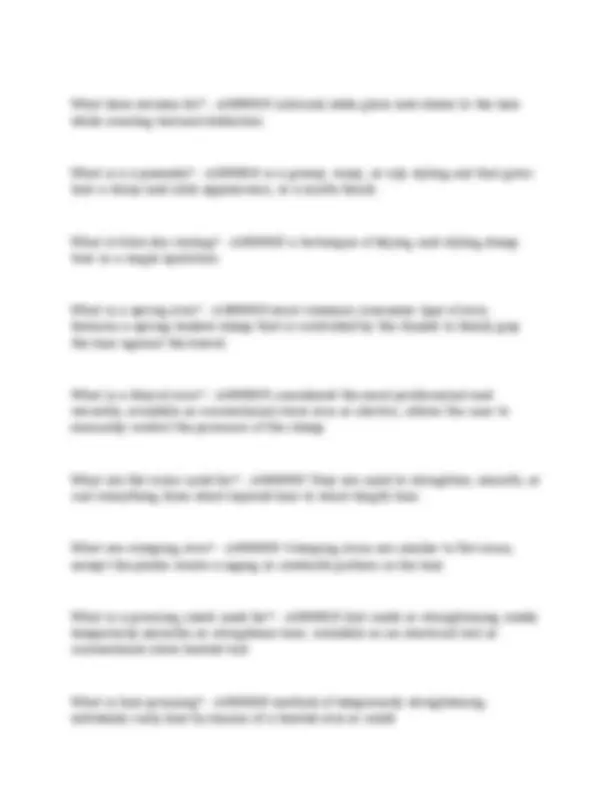
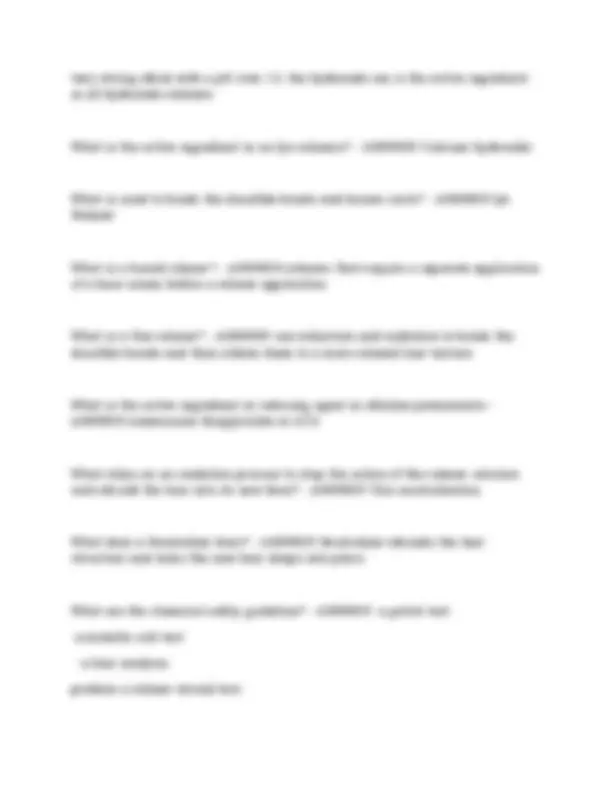
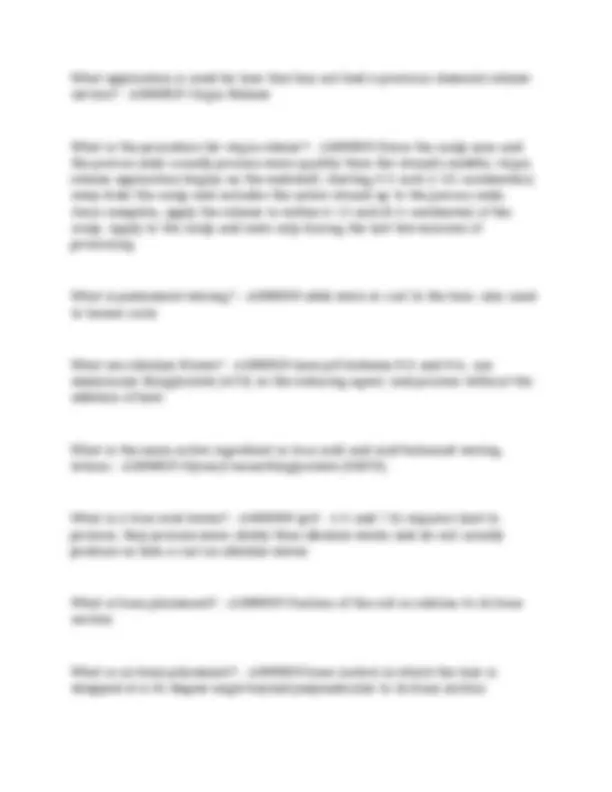
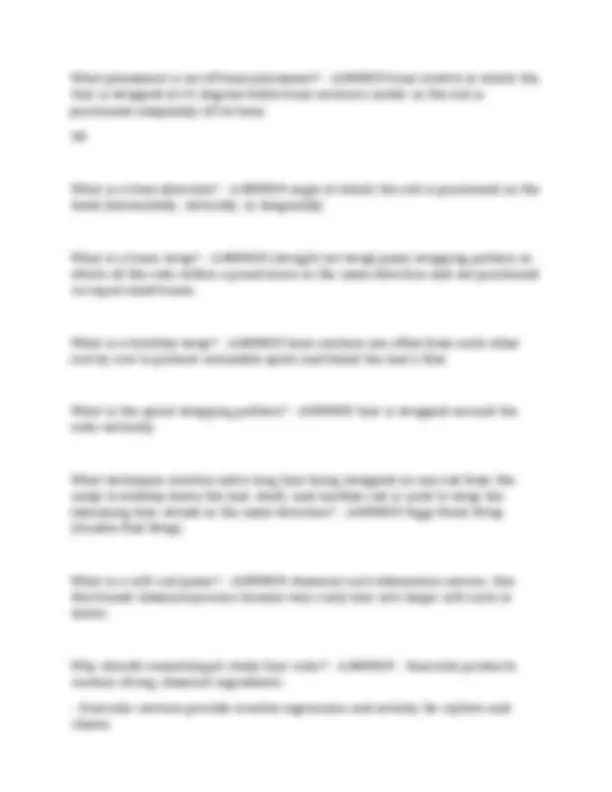
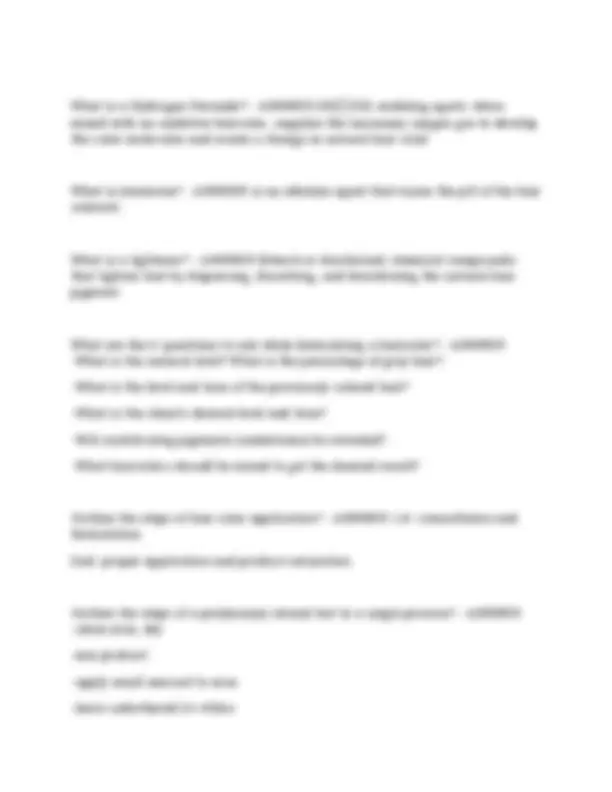
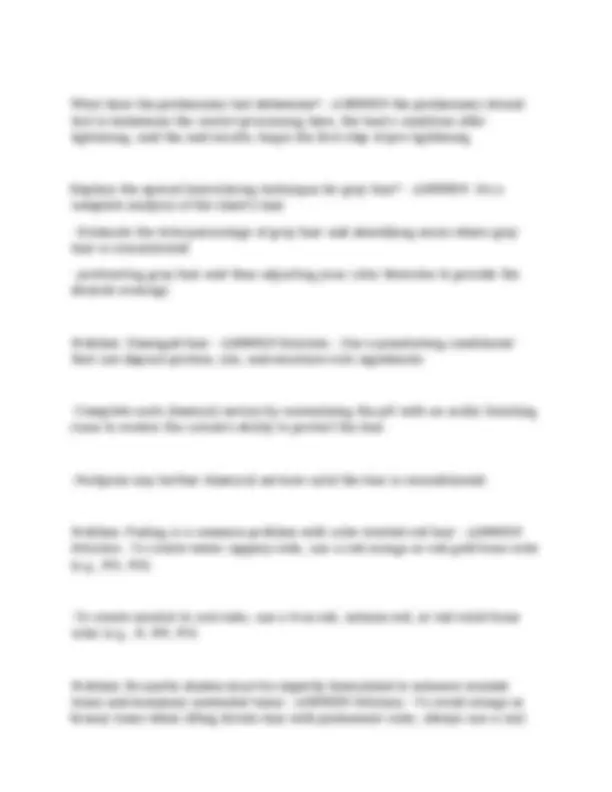
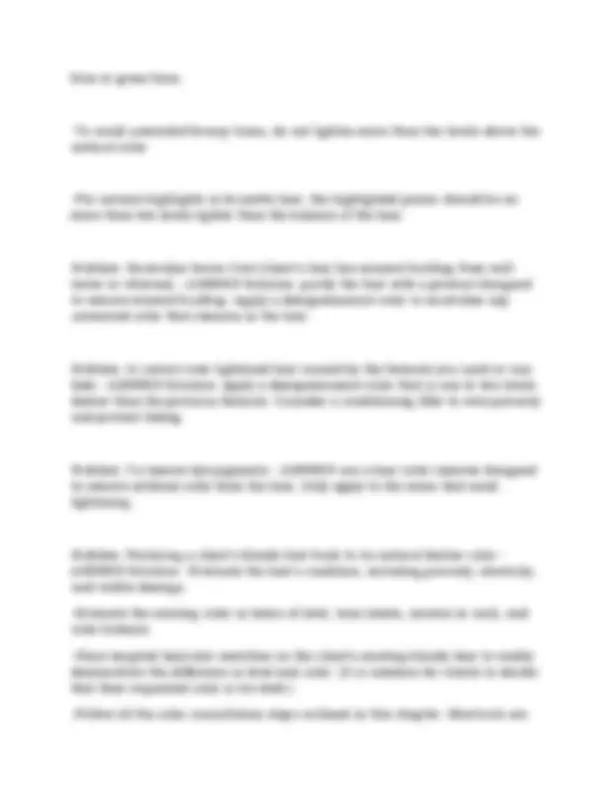
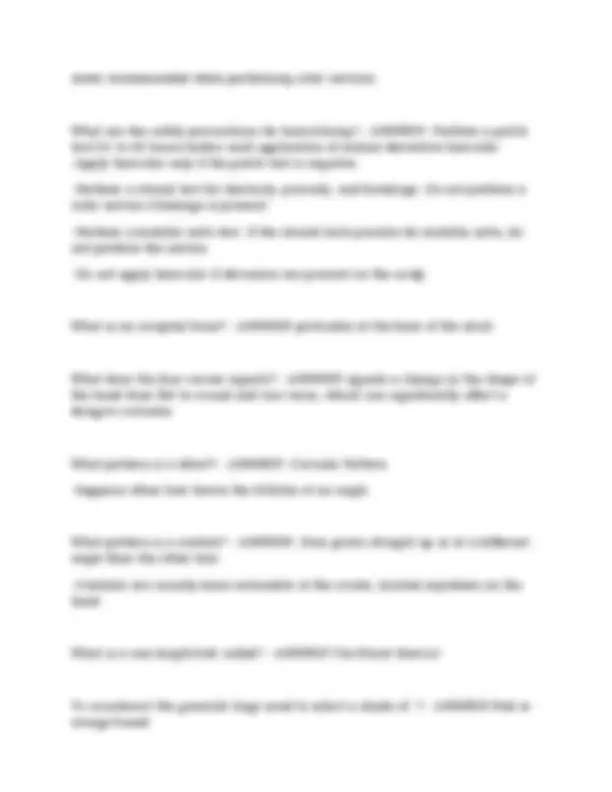
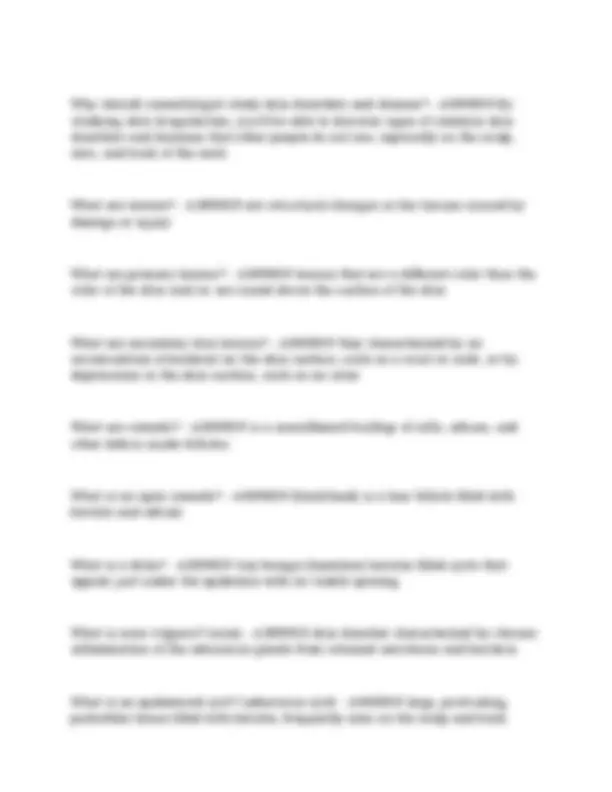
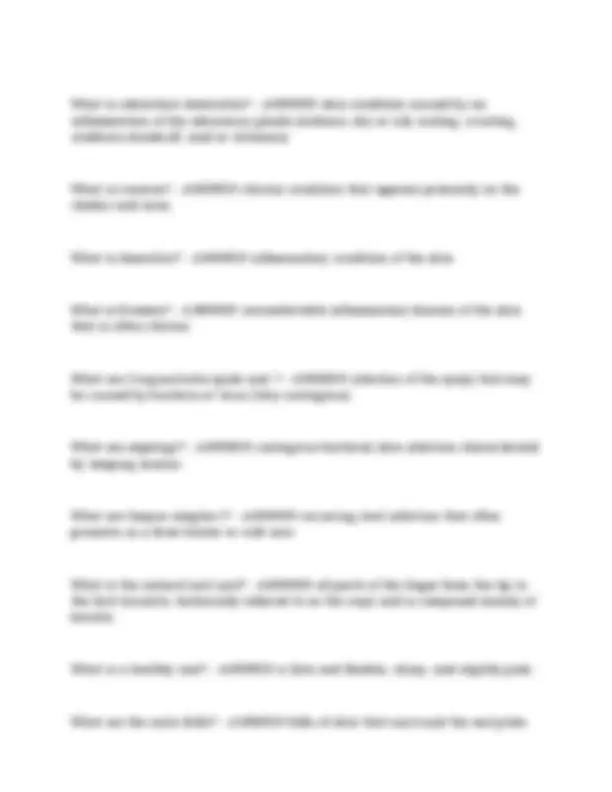
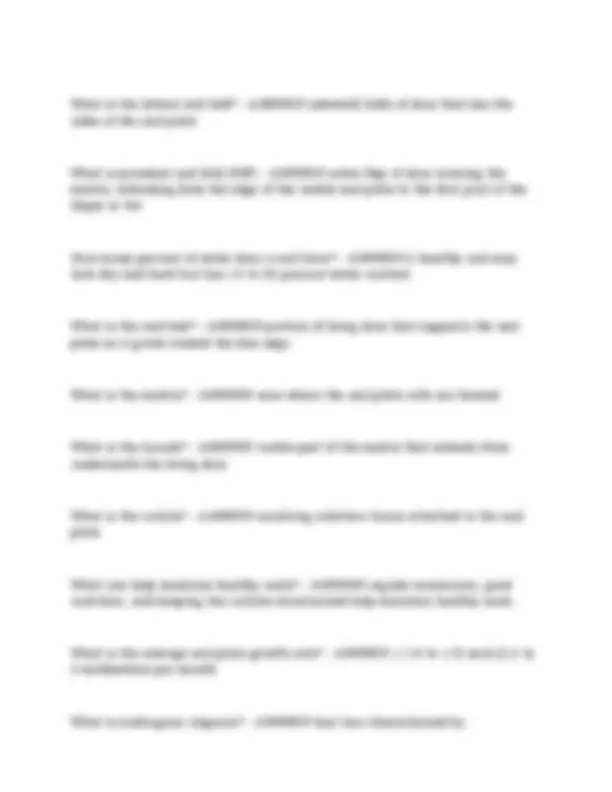

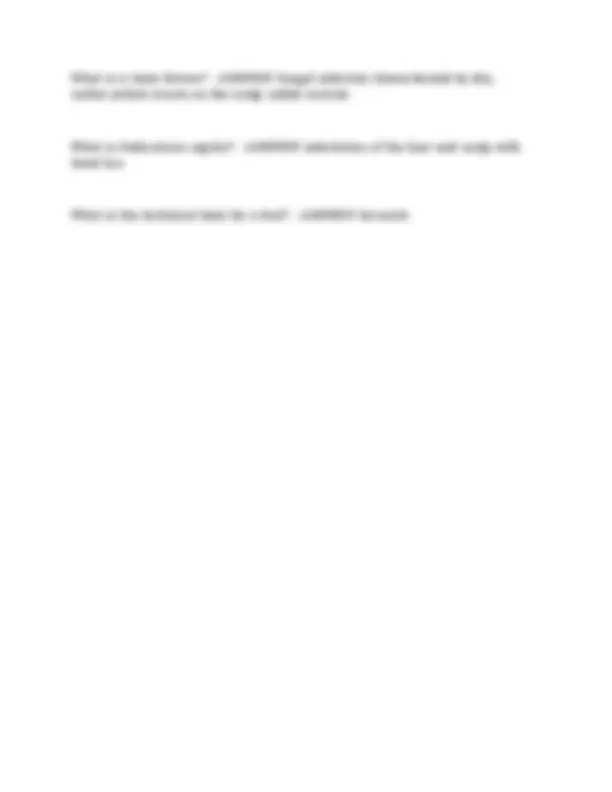


Study with the several resources on Docsity

Earn points by helping other students or get them with a premium plan


Prepare for your exams
Study with the several resources on Docsity

Earn points to download
Earn points by helping other students or get them with a premium plan
Community
Ask the community for help and clear up your study doubts
Discover the best universities in your country according to Docsity users
Free resources
Download our free guides on studying techniques, anxiety management strategies, and thesis advice from Docsity tutors
Cosmetology State Board Exam Questions With Complete Solutions
Typology: Exams
1 / 26

This page cannot be seen from the preview
Don't miss anything!



















Describe the technique for highlights? - ANSWER partial lightening or coloring, coloring some of the hair strands lighter than the natural color to add a variety of lighter shades and the illusion of depth
Outline principles of hair design as applied to sideburns. - ANSWER Sideburns are a primary design element of shorter hair designs.
What is the principle that deals with the comparative relationship of one thing to another in hair design? - ANSWER Proportion
Which principle in hair design relates to establishing equal or appropriate proportions to create symmetry? - ANSWER Balance
What is the term for a regular pulsation or recurrent pattern of movement in a design in hair styling? - ANSWER Rhythm
In hair design, what is the principle that refers to what draws the eye first in a design? - ANSWER Emphasis
Which principle in hair design refers to a design's unity and is considered the most important art principle? - ANSWER Harmony
Why do cosmetologist need a complete understanding of draping, basic scalp care, & shampooing and conditioning. - ANSWER we must understand the different types of shampoo & conditioning products available and what they
offer for various hair types, textures, and hair and scalp conditions.
Also, effective hair cleansing, rinsing, and conditioning provides a clean canvas for styling and finishing.
Explain the benefits of the 3-part client service. - ANSWER It is easier to keep track of what you are doing, remain organized, and give consistent service
What info should you ask your clients before shampoo and conditioning them?
Demonstrate appropriate draping for a basic shampooing and conditioning service & chemical. - ANSWER - Client must sit comfortably
Describe how to correctly brush hair & contribution to a healthy scalp - ANSWER Correct hair brushing stimulates microcirculation to the scalp, helps remove dust, dirt, and hairspray buildup from the hair, and gives it added shine.
Explain the benefits of scalp message. - ANSWER Benefits include increasing scalp microcirculation and calming tenseness
What is balancing shampoo? - ANSWER Washes away excess oil while preventing the hair from drying out
How is color enhancing shampoo created? - ANSWER is created by combining
What are rinse-out conditioners? - ANSWER these are finishing rinses or cream rinses that are rinsed out after they are worked through the hair to detangle and deposit moisturizing benefits.
What are treatment/ repair conditioners? - ANSWER Deep penetrating conditioners restore protein and moisture
What are oil treatments / conditioner? - ANSWER it is ideal for dry scalp and hair. The fatty acids in the oils can replace the lack of natural lipids in the hair to help avoid breakage.
Why should cosmetologist understand haircutting? - ANSWER helps you better understand how to approach any haircut, apply basic haircutting techniques, and be familiar with frequently used haircutting tools.
What is a section? - ANSWER to divide the hair by parting into uniform working areas for control
What is an angle? - ANSWER space between two lines or surfaces that intersect at a given point
What are Horizontal Lines? - ANSWER (side to side) are parallel to the floor and relative to the horizon. It build weight.
What are vertical lines? - ANSWER (up and down) remove weight to create graduated or layered haircuts and are used with higher elevations
What are diagonal lines? - ANSWER Positioned between horizontal and vertical lines & have a slanting or sloping direction
What is an elevation? - ANSWER (projection or lifting) the degree at which a subsection of hair is held, or lifted, from the head when cutting
What is graduation? - ANSWER elevation that occurs when a section is lifted above 0 degrees
What is a finger angle? - ANSWER (cutting position, cutting angle {using degrees}, cutting line, finger position) angle at which the fingers are held when cutting the line that creates the end shape.
What is a guideline? - ANSWER (guide) section of hair, located either at the perimeter or the interior of the cut, that determines the length the hair will be cut; usually the first section that is cut to create a shape
What is a perimeter guideline? - ANSWER an outer line of a haircut
What is a interior guideline? - ANSWER inner or internal line of a haircut
What is a stationary guideline? - ANSWER guideline that does not move
What is a traveling guideline? - ANSWER guideline that moves as the haircutting progresses
What is an overdirection? - ANSWER combing section away from its natural falling position toward a guideline
What is a growth pattern? - ANSWER direction in which the hair grows from the scalp
Demonstrate 3 body positions to ensure a healthier posture while cutting haircutting? - ANSWER - Ensure your client is sitting up straight with legs uncrossed.
4 strategies for safety in haircutting - ANSWER - Always palm the shears and the razor when combing or parting the hair.
What is a blunt haircut? - ANSWER (one-length haircut) haircut in which all the hair comes to one hanging level, forming a weight line or area; hair is cut with no elevation or overdirection
What is a graduated haircut? - ANSWER slow or immediate buildup of weight; an effect or haircut that results from cutting the hair with tension, low to medium elevation, or overdirection
What is a layered haircut? - ANSWER cutting hair with elevation or overdirection; hair is cut at higher elevations, usually 90 degrees or above; removes weight
What is a long-layered haircut? - ANSWER hair is cut at a 90-degree elevation, then overdirected to maintain length and weight at perimeter
What is hairstyling? - ANSWER it is an important, foundational skill that allows
you to display your creativity and deliver a client's desired specific outcome.
What should you look for during a hairstyle consultation? - ANSWER -Diameter -Feel - Pattern -Density
-Condition - length -Porosity/Elasticity
What are vent brushes? - ANSWER Vent brushes speed up drying times due to their vented brush heads and wide-spaced pins.
What is a styling brush? - ANSWER This brush provides a beveled blow-out look, adding smoothness with a bend on the ends of the hair.
What is a paddle brush used for? - ANSWER Can be used on all wave patterns to smooth highly textured hair's cuticle layer
What is a detangling brush? - ANSWER help reduce pressure on the hair and scalp minimizing damage and split ends.
What is a styling comb? - ANSWER it has a fine combing and styling abilities.
What is a cutting comb? - ANSWER (all purpose combs) These combs are ideal for finger waves, detangling, parting and sectioning the hair, wet sets, and thermal styling.
What is a feather comb? - ANSWER it is a tool used in finishing a style and producing different looks.
What does serums do? - ANSWER (silicone) adds gloss and sheen to the hair while creating textural definition.
What is a a pomade? - ANSWER is a greasy, waxy, or oily styling aid that gives hair a shiny and slick appearance, or a matte finish.
What is blow dry styling? - ANSWER a technique of drying and styling damp hair in a single operation
What is a spring iron? - ANSWER most common consumer type of iron; features a spring-loaded clamp that is controlled by the thumb to firmly grip the hair against the barrel
What is a Marcel iron? - ANSWER considered the most professional and versatile; available as conventional stove iron or electric; allows the user to manually control the pressure of the clamp
What are flat irons used for? - ANSWER They are used to straighten, smooth, or curl everything from short-layered hair to waist-length hair.
What are crimping iron? - ANSWER Crimping irons are similar to flat irons, except the plates create a zigzag or sawtooth pattern in the hair
What is a pressing comb used for? - ANSWER (hot comb or straightening comb) temporarily smooths or straightens hair; available as an electrical tool or conventional stove heated tool
What is hair pressing? - ANSWER method of temporarily straightening extremely curly hair by means of a heated iron or comb
What is soft press? - ANSWER removes about 50 to 60 percent of the curl
What is medium press? - ANSWER removes about 60 to 75 percent of the curl
What is a hard press? - ANSWER removes 100 percent of the curl
What is a Curl n' Go - ANSWER (wash ' n ' go) styling method that achieves a free curly or coily defined texture after a cleanser, conditioner, or co-wash; followed by a leave-in conditioner, curl-enhancing cream, gel or foam; hand-styling after hooded dryer, air drying, and /or diffuser
Textured sets and styles - ANSWER style for natural curly or coily hair textures that elongates the natural frizz and makes a smooth-silky curl, wavy, or zigzag pattern when the hair is set wet or dry
What is a bantu knot? - ANSWER style where hair is double-strand twisted or coil twisted and wrapped around itself to make a knot
What is locs? - ANSWER separate networks of curly, textured hair that are intertwined and meshed together
What is a volume base curl? - ANSWER thermal curls placed very high on their base; provide maximum lift or volume
What is a full base curl? - ANSWER thermal curls that sit in the center of their base; strong curls with full volume
What is a half base curl? - ANSWER position of a curl or a roller that sits
very strong alkali with a pH over 13; the hydroxide ion is the active ingredient in all hydroxide relaxers.
What is the active ingredient in no-lye relaxers? - ANSWER Calcium hydroxide
What is used to break the disulfide bonds and loosen curls? - ANSWER lye Relaxer
What is a based relaxer? - ANSWER relaxers that require a separate application of a base cream before a relaxer application
What is a thio relaxer? - ANSWER use reduction and oxidation to break the disulfide bonds and then reform them to a more relaxed hair texture
What is the active ingredient or reducing agent in alkaline permanents - ANSWER Ammonium thioglycolate or ATG
What relies on an oxidation process to stop the action of the relaxer solution and rebuild the hair into its new form? - ANSWER Thio neutralization
What does a Neutralizer does? - ANSWER Neutralizer rebonds the hair structure and locks the new hair shape into place.
What are the chemical safety guideline? - ANSWER -a patch test
-a metallic salt test
-a hair analysis
preform a relaxer strand test.
What application is used for hair that has not had a previous chemical relaxer service? - ANSWER Virgin Relaxer
What is the procedure for virgin relaxer? - ANSWER Since the scalp area and the porous ends usually process more quickly than the strand's middle, virgin relaxer application begins on the midshaft, starting 0.5 inch (1.25 centimeters) away from the scalp and includes the entire strand up to the porous ends. Once complete, apply the relaxer to within 0.13 inch (0.3 centimeter) of the scalp. Apply to the scalp and ends only during the last few minutes of processing.
What is permanent waving? - ANSWER adds wave or curl to the hair; also used to loosen curls
What are Alkaline Waves? - ANSWER have pH between 9.0 and 9.6, use ammonium thioglycolate (ATG) as the reducing agent, and process without the addition of heat
What is the main active ingredient in true acid and acid-balanced waving lotions - ANSWER Glyceryl monothioglycolate (GMTG)
What is a true acid waves? - ANSWER (pH - 4.5 and 7.0) requires heat to process; they process more slowly than alkaline waves and do not usually produce as firm a curl as alkaline waves
What is base placement? - ANSWER Position of the rod in relation to its base section
What is on-base placement? - ANSWER base control in which the hair is wrapped at a 45-degree angle beyond perpendicular to its base section
How does the cuticle haircolor? - ANSWER color fade is problematic; non-oxidative haircolor deposits hair dye molecules only on this layer.
How does the Cortex affect the haircolor? - ANSWER contains the natural pigment called melanin that determines hair color; oxidative hair dye molecules are deposited here.
How does medium-textured hair react to hair color? - ANSWER it contains melanin that is tightly packed together. It colors more quickly and can look darker.
How does medium-textured hair react to hair color? - ANSWER has an average reaction to haircolor.
How does coarse-textured hair react to hair color? - ANSWER haircolor can take longer to process.
How does the hair density affect the haircolor? - ANSWER Density must be taken into account when applying haircolor to ensure proper coverage.
What does it mean when the hair has low porosity? - ANSWER -the cuticle is tight so it's difficult for moisture or chemicals to penetrate it. Hair will require a longer processing time.
What does it mean when the hair has average porosity? - ANSWER the cuticle is slightly raised. Hair will process in an average amount of time. Typically has little to no difficulty absorbing or retaining moisture.
What does it mean when the hair has high porosity? - ANSWER -the cuticle is lifted. The hair is overly porous, allows moisture to easily penetrate, and therefore will take color quickly. Color also tends to fade quickly. Permed, colored, chemically relaxed, and straightened hair will have a high degree of porosity.
What are primary colors? - ANSWER pure or fundamental colors (red, yellow, blue) that cannot be created by combining other colors
What is the strongest primary color? - ANSWER Blue
What is the medium primary color? - ANSWER Red
What is the weakest primary color? - ANSWER Yellow
What is the secondary color? - ANSWER color obtained by mixing equal parts of two primary colors
What is a tertiary color? - ANSWER intermediate color achieved by mixing a secondary color and its neighboring primary color on the color wheel in equal amounts
What are complementary colors? - ANSWER primary and secondary colors positioned directly opposite each other on the color wheel
What refers to color balance? (warm, color and neutral) - ANSWER Tone
What is the strength of a color? - ANSWER Intensity
What does the preliminary test determine? - ANSWER the preliminary strand test to determine the correct processing time, the hair's condition after lightening, and the end results, begin the first step of pre-lightening.
Explain the special haircoloring technique for gray hair? - ANSWER -Do a complete analysis of the client's hair
Problem: Damaged hair - ANSWER Solution: -Use a penetrating conditioner that can deposit protein, oils, and moisture-rich ingredients.
-Complete each chemical service by normalizing the pH with an acidic finishing rinse to restore the cuticle's ability to protect the hair.
-Postpone any further chemical services until the hair is reconditioned.
Problem: Fading is a common problem with color-treated red hair - ANSWER Solution: -To create warm coppery reds, use a red-orange or red-gold base color (e.g., RO, RG).
-To create neutral to cool reds, use a true red, intense red, or red-violet base color (e.g., R, RR, RV).
Problem: Brunette shades must be expertly formulated to enhance wanted tones and minimize unwanted tones - ANSWER Solution: -To avoid orange or brassy tones when lifting brown hair with permanent color, always use a cool
blue or green base.
-To avoid unwanted brassy tones, do not lighten more than two levels above the natural color.
-For natural highlights in brunette hair, the highlighted pieces should be no more than two levels lighter than the balance of the hair.
Problem: Neutralize Green Cast (client's hair has mineral buildup from well water or chlorine) - ANSWER Solution: purify the hair with a product designed to remove mineral buildup. Apply a demipermanent color to neutralize any unwanted color that remains in the hair.
Problem: to correct over-lightened hair caused by the formula you used or sun fade - ANSWER Solution: apply a demipermanent color that is one to two levels darker than the previous formula. Consider a conditioning filler to even porosity and prevent fading.
Problem: To remove dye pigments - ANSWER use a hair color remover designed to remove artificial color from the hair; Only apply to the areas that need lightening.
Problem: Restoring a client's blonde hair back to its natural darker color - ANSWER Solution: -Evaluate the hair's condition, including porosity, elasticity, and visible damage.
-Evaluate the existing color in terms of level, tone (warm, neutral or cool), and color balance.
-Place targeted haircolor swatches on the client's existing blonde hair to visibly demonstrate the difference in level and color. (It is common for clients to decide that their requested color is too dark.)
-Follow all the color consultation steps outlined in this chapter. Shortcuts are